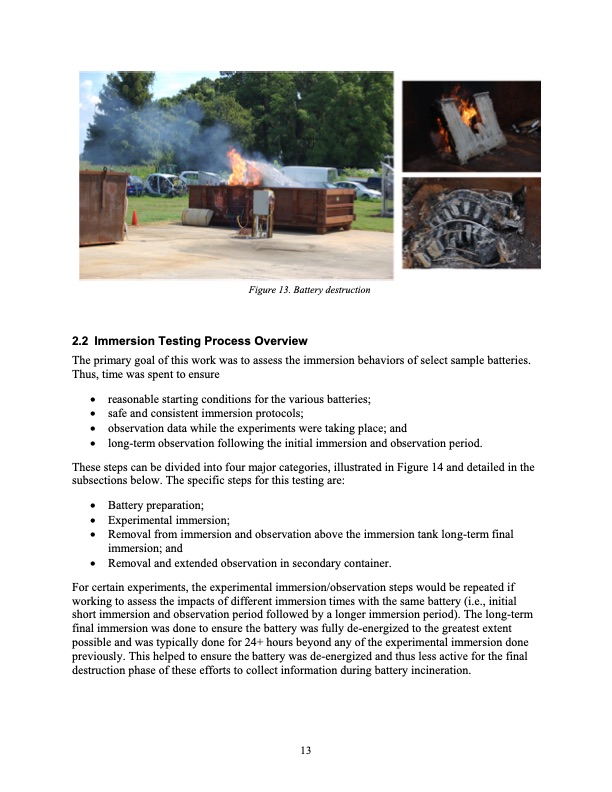
PDF Publication Title:
Text from PDF Page: 017
Figure 13. Battery destruction 2.2 Immersion Testing Process Overview The primary goal of this work was to assess the immersion behaviors of select sample batteries. Thus, time was spent to ensure reasonable starting conditions for the various batteries; safe and consistent immersion protocols; observation data while the experiments were taking place; and long-term observation following the initial immersion and observation period. These steps can be divided into four major categories, illustrated in Figure 14 and detailed in the subsections below. The specific steps for this testing are: Battery preparation; Experimental immersion; Removal from immersion and observation above the immersion tank long-term final immersion; and Removal and extended observation in secondary container. For certain experiments, the experimental immersion/observation steps would be repeated if working to assess the impacts of different immersion times with the same battery (i.e., initial short immersion and observation period followed by a longer immersion period). The long-term final immersion was done to ensure the battery was fully de-energized to the greatest extent possible and was typically done for 24+ hours beyond any of the experimental immersion done previously. This helped to ensure the battery was de-energized and thus less active for the final destruction phase of these efforts to collect information during battery incineration. 13PDF Image | Li-Ion Battery Pack Immersion Exploratory Investigation

PDF Search Title:
Li-Ion Battery Pack Immersion Exploratory InvestigationOriginal File Name Searched:
dot_57013_DS1.pdfDIY PDF Search: Google It | Yahoo | Bing
Product and Development Focus for Salgenx
Redox Flow Battery Technology: With the advent of the new USA tax credits for producing and selling batteries ($35/kW) we are focussing on a simple flow battery using shipping containers as the modular electrolyte storage units with tax credits up to $140,000 per system. Our main focus is on the salt battery. This battery can be used for both thermal and electrical storage applications. We call it the Cogeneration Battery or Cogen Battery. One project is converting salt (brine) based water conditioners to simultaneously produce power. In addition, there are many opportunities to extract Lithium from brine (salt lakes, groundwater, and producer water).Salt water or brine are huge sources for lithium. Most of the worlds lithium is acquired from a brine source. It's even in seawater in a low concentration. Brine is also a byproduct of huge powerplants, which can now use that as an electrolyte and a huge flow battery (which allows storage at the source).We welcome any business and equipment inquiries, as well as licensing our flow battery manufacturing.| CONTACT TEL: 608-238-6001 Email: greg@salgenx.com | RSS | AMP |